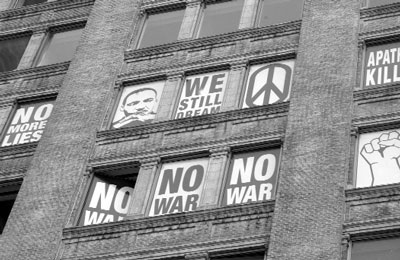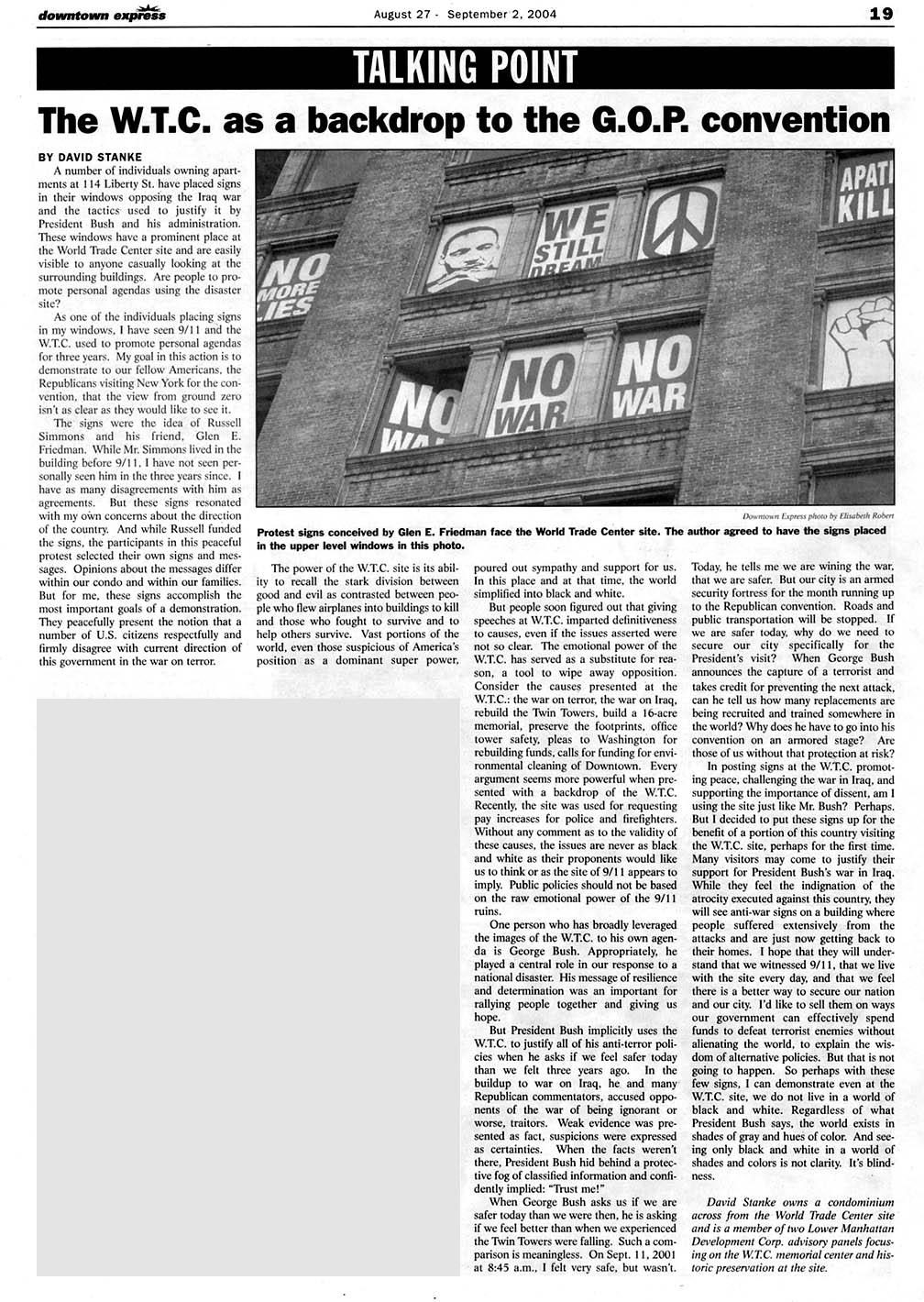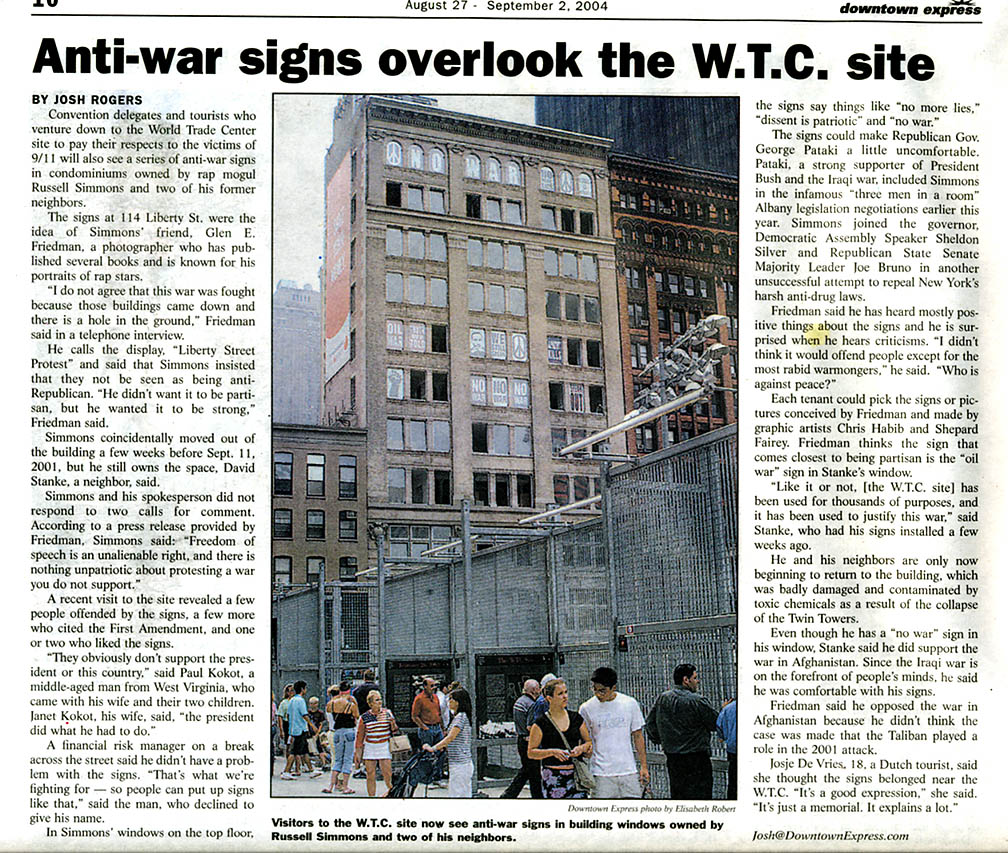
Volume 18 - Issue 14h
August 27 - September 02, 2004
** Two Articles Below **

Downtown Express photo by Elisabeth Robert
Protest signs conceived by Glen E. Friedman face the World Trade Center site.
The author agreed to have the signs placed in the upper level windows in this photo.
By David Stanke
A number of individuals owning apartments at 114 Liberty St. have placed signs in their windows opposing the Iraq war and the tactics used to justify it by President Bush and his administration. These windows have a prominent place at the World Trade Center site and are easily visible to anyone casually looking at the surrounding buildings. Are people to promote personal agendas using the disaster site?
As one of the individuals placing signs in my windows, I have seen 9/11 and the W.T.C. used to promote personal agendas for three years. My goal in this action is to demonstrate to our fellow Americans, the Republicans visiting New York for the convention, that the view from ground zero isn't as clear as they would like to see it.
The signs were the idea of Russell Simmons and his friend, Glen E. Friedman. While Mr. Simmons lived in the building before 9/11, I have not seen personally seen him in the three years since. I have as many disagreements with him as agreements. But these signs resonated with my own concerns about the direction of the country. And while Russell funded the signs, the participants in this peaceful protest selected their own signs and messages. Opinions about the messages differ within our condo and within our families. But for me, these signs accomplish the most important goals of a demonstration. They peacefully present the notion that a number of U.S. citizens respectfully and firmly disagree with current direction of this government in the war on terror.
The power of the W.T.C. site is its ability to recall the stark division between good and evil as contrasted between people who flew airplanes into buildings to kill and those who fought to survive and to help others survive. Vast portions of the world, even those suspicious of America's position as a dominant super power, poured out sympathy and support for us. In this place and at that time, the world simplified into black and white.
But people soon figured out that giving speeches at W.T.C. imparted definitiveness to causes, even if the issues asserted were not so clear. The emotional power of the W.T.C. has served as a substitute for reason, a tool to wipe away opposition. Consider the causes presented at the W.T.C.: the war on terror, the war on Iraq, rebuild the Twin Towers, build a 16-acre memorial, preserve the footprints, office tower safety, pleas to Washington for rebuilding funds, calls for funding for environmental cleaning of Downtown. Every argument seems more powerful when presented with a backdrop of the W.T.C. Recently, the site was used for requesting pay increases for police and firefighters. Without any comment as to the validity of these causes, the issues are never as black and white as their proponents would like us to think or as the site of 9/11 appears to imply. Public policies should not be based on the raw emotional power of the 9/11 ruins.
One person who has broadly leveraged the images of the W.T.C. to his own agenda is George Bush. Appropriately, he played a central role in our response to a national disaster. His message of resilience and determination was an important for rallying people together and giving us hope.
But President Bush implicitly uses the W.T.C. to justify all of his anti-terror policies when he asks if we feel safer today than we felt three years ago. In the buildup to war on Iraq, he and many Republican commentators, accused opponents of the war of being ignorant or worse, traitors. Weak evidence was presented as fact, suspicions were expressed as certainties. When the facts weren't there, President Bush hid behind a protective fog of classified information and confidently implied: "Trust me!"
When George Bush asks us if we are safer today than we were then, he is asking if we feel better than when we experienced the Twin Towers were falling. Such a comparison is meaningless. On Sept. 11, 2001 at 8:45 a.m., I felt very safe, but wasn't. Today, he tells me we are wining the war, that we are safer. But our city is an armed security fortress for the month running up to the Republican convention. Roads and public transportation will be stopped. If we are safer today, why do we need to secure our city specifically for the President's visit? When George Bush announces the capture of a terrorist and takes credit for preventing the next attack, can he tell us how many replacements are being recruited and trained somewhere in the world? Why does he have to go into his convention on an armored stage? Are those of us without that protection at risk?
In posting signs at the W.T.C. promoting peace, challenging the war in Iraq, and supporting the importance of dissent, am I using the site just like Mr. Bush? Perhaps. But I decided to put these signs up for the benefit of a portion of this country visiting the W.T.C. site, perhaps for the first time. Many visitors may come to justify their support for President Bush's war in Iraq. While they feel the indignation of the atrocity executed against this country, they will see anti-war signs on a building where people suffered extensively from the attacks and are just now getting back to their homes. I hope that they will understand that we witnessed 9/11, that we live with the site every day, and that we feel there is a better way to secure our nation and our city. I'd like to sell them on ways our government can effectively spend funds to defeat terrorist enemies without alienating the world, to explain the wisdom of alternative policies. But that is not going to happen. So perhaps with these few signs, I can demonstrate even at the W.T.C. site, we do not live in a world of black and white. Regardless of what President Bush says, the world exists in shades of gray and hues of color. And seeing only black and white in a world of shades and colors is not clarity. It's blindness.
David Stanke owns a condominium across from the World Trade Center site and is a member of two Lower Manhattan Development Corp. advisory panels focusing on the W.T.C. memorial center and historic preservation at the site.
By Josh Rogers
Visitors to the W.T.C. site now see anti-war signs in building windows owned by Russell Simmons and two of his neighbors.
Convention delegates and tourists who venture down to the World Trade Center site to pay their respects to the victims of 9/11 will also see a series of anti-war signs in condominiums owned by rap mogul Russell Simmons and two of his former neighbors.
The signs at 114 Liberty St. were the idea of Simmons' friend, Glen E. Friedman, a photographer who has published several books and is known for his portraits of rap stars.
"I do not agree that this war was fought because those buildings came down and there is a hole in the ground," Friedman said in a telephone interview.
He calls the display, "Liberty Street Protest" and said that Simmons insisted that they not be seen as being anti-Republican. "He didn't want it to be partisan, but he wanted it to be strong," Friedman said.
Simmons coincidentally moved out of the building a few weeks before Sept. 11, 2001, but he still owns the space, David Stanke, a neighbor, said.
Simmons and his spokesperson did not respond to two calls for comment. According to a press release provided by Friedman, Simmons said: "Freedom of speech is an unalienable right, and there is nothing unpatriotic about protesting a war you do not support."
A recent visit to the site revealed a few people offended by the signs, a few more who cited the First Amendment, and one or two who liked the signs.
"They obviously don't support the president or this country," said Paul Kokot, a middle-aged man from West Virginia, who came with his wife and their two children. Janet Kokot, his wife, said, "the president did what he had to do."
A financial risk manager on a break across the street said he didn't have a problem with the signs. "That's what we're fighting for- so people can put up signs like that," said the man, who declined to give his name.
In Simmons' windows on the top floor, the signs say things like "no more lies," "dissent is patriotic" and "no war."
The signs could make Republican Gov. George Pataki a little uncomfortable. Pataki, a strong supporter of President Bush and the Iraqi war, included Simmons in the infamous "three men in a room" Albany legislation negotiations earlier this year. Simmons joined the governor, Democratic Assembly Speaker Sheldon Silver and Republican State Senate Majority Leader Joe Bruno in another unsuccessful attempt to repeal New York's harsh anti-drug laws.
Friedman said he has heard mostly positive things about the signs and he is surprised when he hears criticisms. "I didn't think it would offend people except for the most rabid warmongers," he said. "Who is against peace?"
Each tenant could pick the signs or pictures conceived by Friedman and made by graphic artists Chris Habib and Shepard Fairey. Friedman thinks the sign that comes closest to being partisan is the "oil war" sign in Stanke's window.
"Like it or not, [the W.T.C. site] has been used for thousands of purposes, and it has been used to justify this war," said Stanke, who had his signs installed a few weeks ago. He and his neighbors are only now beginning to return to the building, which was badly damaged and contaminated by toxic chemicals as a result of the collapse of the Twin Towers.
Even though he has a "no war" sign in his window, Stanke said he did support the war in Afghanistan. Since the Iraqi war is on the forefront of people's minds, he said he was comfortable with his signs.
Friedman said he opposed the war in Afghanistan because he didn't think the case was made that the Taliban played a role in the 2001 attack.
Josje De Vries, 18, a Dutch tourist, said she thought the signs belonged near the W.T.C. "It's a good expression," she said. "It's just a memorial. It explains a lot."
write to the author at : Josh@DowntownExpress.com

